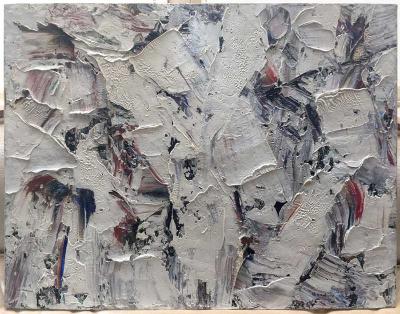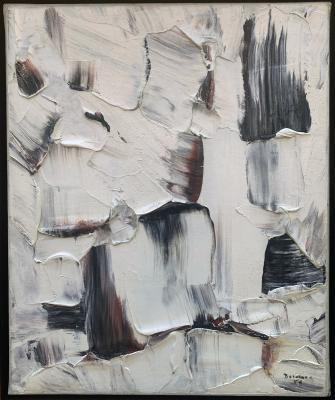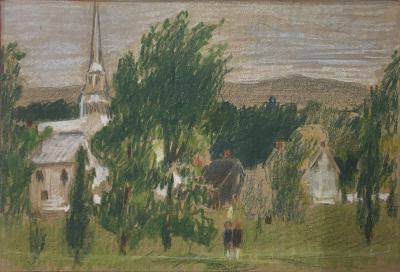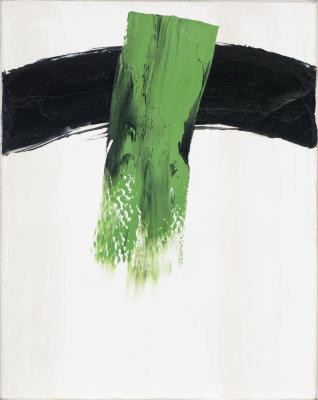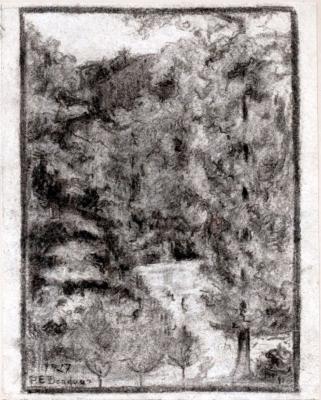Bibliographie: Paul-Émile Borduas, Le Devoir, Montréal, 9 et 11 juin, 1956
Historique: In 1956, Borduas had already been in Paris for a while. He left New York on September 21, 1955 on the steamship Liberté, accompanied by his daughter Jeannine, and arrived in Le Havre five days later. He was in Paris on September 27, and settled at 19 rue Rousselet in a small studio found for him by Jean-Paul Riopelle and Gilles Corbeil. He was not happy with the choice and would move upstairs at the same address a little later. After the loft where he lived in New York, the Parisian accommodation might have seemed rather skimpy.
It is usual to associate the famous Black and White Borduas pictures with his Parisian period. And it may come as a surprise that a canvas like Composition, 1956 – a few words will be added about this title further on – could have been painted in Paris. In fact, Borduas did not produce Black and White paintings immediately after his arrival in Paris. What we see, on the contrary, is the logical development of what he did in New York the year before. Borduas noted in a text sent to Jean-René Ostiguy, then at the National Gallery of Canada, which would be published in Le Devoir on June 9 and 11, 1956, “Even if these pictures became whiter and whiter, and more and more ‘objective’ with time, they still maintain a high degree of complexity, when I see all around me works with a clear and a precise meaning, from expressionism to graphism...My own always seem to make an emotional synthesis of so many elements.” In fact what was prevailing in Borduas’s painting at the beginning of his Paris stay was a clearer affirmation of the pictorial plane. We are far from the three-dimensional depth effects of his automatist period. Here, on the contrary, the surface was expressing “the totality of space”. This surface could be slightly modulated, as in the present case, but there is no way to read into it some endlessly receding horizon or some infinite depth.
One is reminded that the great paradigm of painting since the Renaissance, which was to compare a painting to a window open on the world, was replaced in modern times by another one: the wall, as prophetically predicted in Honoré de Balzac’s short story, “Le Chef d’oeuvre inconnu”, 1837. Balzac tells the story of an old artist, Frenhofer, who was obsessed with his portrait of the beautiful Catherine Lescault. He ceaselessly repainted it, as he wanted it to be his last masterpiece. But when he showed it to his visitors, Nicolas Poussin and Master Porbus, they could only see “un mur de peinture (a wall of painting)”. It was as if the canvas, being a surface, could not allow any other effects than those of surface. The painting had become abstract – it was not any longer a window open into reality, but a wall of painting. It was impossible to read its subject matter, except for one detail - the model’s foot in one corner.
In New York, the American critic Clement Greenberg had stressed similarly that a painting being done on a surface must respect a certain flatness to not undermine its basic structure. Under his influence in New York at the time, there was a move to a more and more decisive affirmation of the pictorial plane among the artists admired by Borduas, such as Jackson Pollock, Clyfford Still and Barnett Newman.
Regarding the title, Composition is probably not the title given by Borduas. It is too general and not poetic enough. We know of the titles of two paintings acquired by Laing in March 1956 which had exactly the same dimensions as this one: Modulation aux points noirs and Girouette. In our painting also, the black modulates the surface and the contradictory handlings of the palette knife could suggest the movements of the weathercock (“girouette” in French). Either of these two titles could apply to our painting, but unfortunately, it is impossible to make more than a mere conjecture given the state of our documentation today.
We thank François-Marc Gagnon of the Gail and Stephen A. Jarislowsky Institute of Studies in Canadian Art, Concordia University, for contributing the above essay.

